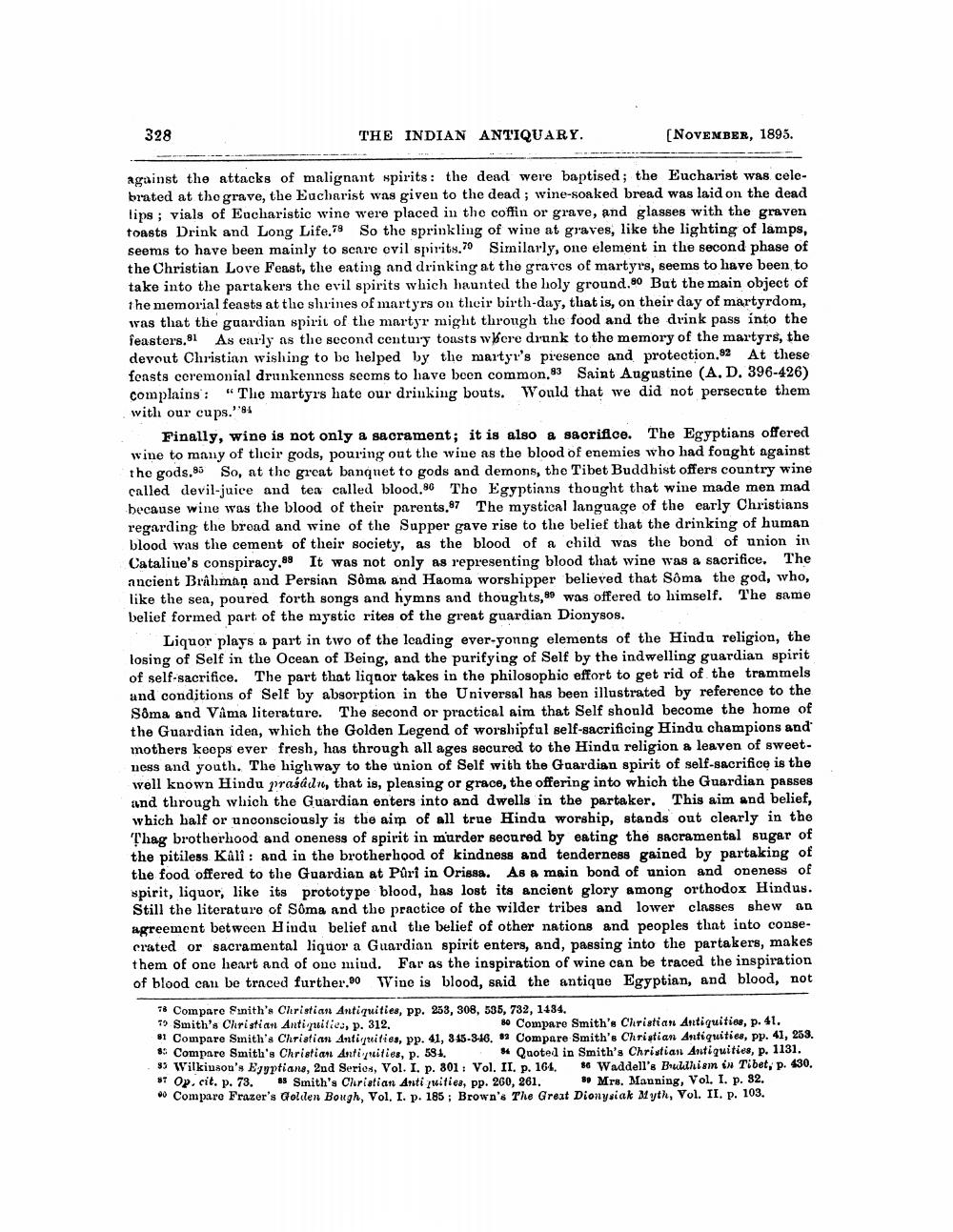________________
328
THE INDIAN ANTIQUARY.
(NOVEMBER, 1895.
against the attacks of malignant spirits: the dead were baptised; the Eucharist was celebrated at the grave, the Eucharist was given to the dead; wine-soaked bread was laid on the dead lips; vials of Eucharistic wine were placed in the coffin or grave, and glasses with the graven toasts Drink and Long Life. So the sprinkling of wine at graves, like the lighting of lamps, seems to have been mainly to scare evil spirits.79 Similarly, one element in the second phase of the Christian Love Feast, the eating and drinking at the graves of martyrs, seems to have been to take into the partakers the evil spirits which haunted the holy ground.90 But the main object of the memorial feasts at the shrines of martyrs on their birth-day, that is, on their day of martyrdom, was that the guardian spirit of the martyr might through the food and the drink pass into the feasters.81 As early as the second century toasts were drunk to the memory of the martyrs, the devout Christian wishing to be helped by the martyr's presence and protection. At these feasts ceremonial drunkenness seems to have been common.83 Saint Augustine (A, D, 396-426) complains : " The martyrs hate our drinking bouts. Would that we did not persecute them with our cups."95
Finally, wine is not only a sacrament; it is also a sacrifice. The Egyptians offered wine to many of their gods, pouring out the wine as the blood of enemies who had fought against the gods.95 So, at the great banqnet to gods and demons, the Tibet Buddhist offers country wine called devil-juice and ten called blood.86 Tho Egyptians thought that wine made men mad because wine was the blood of their parents.97 The mystical language of the early Christians regarding the bread and wine of the Supper gave rise to the belief that the drinking of human blood was the cement of their society, as the blood of a child was the bond of union in Cataliue's conspiracy.88 It was not only as representing blood that wine was a sacrifice. The ancient Brahman and Persian Sôma and Haoma worshipper believed that Sôma the god, who, like the sea, poured forth songs and hymns and thoughts, was offered to himself. The same belief formed part of the mystic rites of the great guardian Dionysos.
Liquor plays a part in two of the leading ever-yonng elements of the Hinda religion, the losing of Self in the Ocean of Being, and the purifying of Self by the indwelling guardian spirit of self-sacrifice. The part that liqaor takes in the philosophic effort to get rid of the trammels and conditions of Self by absorption in the Universal has been illustrated by reference to the Sôma and Vama literature. The second or practical aim that Self should become the home of the Guardian iden, which the Golden Legend of worshipful self-sacrificing Hindu champions and mothers keeps ever fresh, has through all ages secured to the Hindu religion a leaven of sweetness and youth. The highway to the union of Self with the Guardian spirit of self-sacrifice is the well known Hindu prasádn, that is, pleasing or grace, the offering into which the Guardian passes and through which the Guardian enters into and dwells in the partaker. This aim and belief, which half or unconsciously is the aim of all true Hindu worship, stands out clearly in the Thag brotherhood and oneness of spirit in murder secured by eating the sacramental sugar of the pitiless Kali: and in the brotherhood of kindness and tenderness gained by partaking of the food offered to the Guardian at Puri in Orissa. As a main bond of union and oneness of spirit, liquor, like its prototype blood, has lost its ancient glory among orthodox Hindus. Still the literature of Soma and the practice of the wilder tribes and lower classes shewan agreement between Hindu belief and the belief of other nations and peoples that into consecrated or sacramental liquor a Guardian spirit enters, and, passing into the partakers, makes them of one heart and of one mind. Far as the inspiration of wine can be traced the inspiration of blood can be traced further.80 Wine is blood, said the antique Egyptian, and blood, not
78 Compare Sunith's Christian Antiquities, pp. 253, 308, 535, 732, 1434. 79 Smith's Christian Antiquities, p. 312.
80 Compare Smith's Christian Antiquities, p. 41. #1 Compare Smith's Christian Antiquities, pp. 41, 345-3-16. Compare Smith's Christian Antiquities, pp. 41, 263, S: Compare Smith's Christian Antiquities, p. 581. * Quoted in Smith's Christian Antiquities, p. 1131. 3 Wilkinson's Egyptians, 2nd Series, Vol. I. p. 801 : Vol. II. p. 164. 6 Waddell's Bullhism in Tibet, p. 130. 57 Op. cit. p. 73. Smith's Christian Antiquities, pp. 260, 261, Mrs. Manning, Vol. I. p. 82. * Compare Frazer's Golden Bough, Vol. I. p. 185; Brown's The Great Dionysiak Myth, Vol. II. p. 103.




